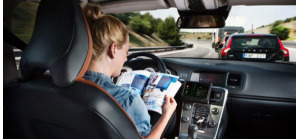Safe, no accident highways! – Reality or fiction?
There are over 1 Billion vehicles on our worldwide roadways. There are over 1 Million automobile fatalities worldwide each year. 90% of these accidents are caused by human error and distraction. The majority of these fatal accidents are preventable.
In 1939, General Motors ran a movie (“New Horizons”) at the World’s Fair predicting what the world would be like in 1960. In the New Horizons movie, GM predicted what lay ahead for the automobile, driving and our roadways. In short, they forecast that the Driverless Car would be realized through the innovative application of technology.
“A safe distance between cars is maintained by automatic radio control. The keynote of the motorway — safety with increased speed.”
GM’s prediction would not be realized in 1960, however today in 2015, these 1939 predictions are closer than ever. Autonomous, or Driverless, Cars may soon be doing the driving for us.
We aren’t far off from being chauffeured to and from our destinations. In order for the realization of Driverless Cars, technology and innovation have to cross paths in a manner that allows the vehicle to perceive the world around us using sensors, lasers, radars and cameras.
Imagine an automobile transportation system where:
- Checking that text message while driving without risking the lives of others is possible.
- Reading a book on your commute to work.
- The elderly are not a hazard to themselves and others as their cognitive abilities decline.
- The blind are able to “drive” where they need to go, or be driven.
- The family car gets the kids to practice without the parent doing the driving.
- There are No traffic jams!
HOW IS THIS SCIENCE FICTION EVEN POSSIBLE?
Well, it is about data and the application of technology. You see robots and machines can process data in sub-second fashion. Computers are really good with math. In a split second decision — whether to hit the brakes and at what force to avoid an accident — unlike a human, a computer can make the appropriate calculation consistently right. In the not so distant future, computer driven cars will be making decisions like these every 1/100th of a second. Combined with the accelerometers and gyroscopes in vehicles, computers are not prone to the same accident causing error and distractions that humans are.
Safe driverless cars are a math problem. The driverless car will be processing millions of data points at a rate that humans simply can’t process. This processing will enable Situational Awareness beyond what the human computer can deliver. Imagine a forcefield of sorts that expands upon the forcefield available in cars today — today cars talk to us and report on the situation. For example, other cars near us, traffic ahead, upcoming turns, puddles and potholes. We then have to act on the data points. Soon the onboard computers of driverless cars will not only develop the situational awareness for us, but also act on it without us even needing to know about it.
Scary? Worried about control? What about safety? Realize this, there are close to 40 Million commercial flights a year that transport about 5 Billion people. The deadliest year on record for airline travel was 1972, which saw 2,429 deaths. 2014 saw 761 deaths attributed to airline accidents. That is a significant delta from the 1M+ fatalities on our roadways each year. Did you know that airplane autopilot was developed in 1912, demonstrated in 1914 and became standard on planes in the 1940’s? Ships became driverless in the 1920’s. Even the Space Shuttle had autopilot technology on board. We trust in “Autodrive” for our air travel, why not for our road travel?
Just as on airplanes, boats and even the Space Shuttle, steering wheels will exist in the first few decades of commercial driverless cars. They will be necessary for us to gain a comfort level with our soon to be realized Mechanical Chauffeurs. We won’t give up control, rather, we will share control with our cars by enabling an Autodrive mode.
When? We will begin to see early driverless cars on our interstates over the next few years. By 2025, driverless cars will be mainstream on our high speed highways. It will likely be an additional decade, or about 2035, before we see driverless cars mainstream in urban areas and in our neighborhoods.
Next? Well I predict that by 2025 with the advancement of the driverless vehicle and the continued innovation of automobile and flight based technology, we will begin to see vehicles that can not only drive themselves, but also FLY.

